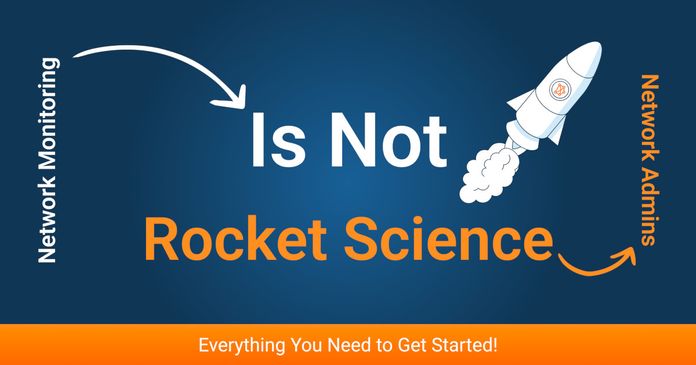Table of Contents
Table of Contents
Welcome to "Network Connection Monitoring 101: Your Path to Network Nirvana," a guide tailored for businesses seeking to optimize their network infrastructure. In today's digital landscape, where uninterrupted connectivity is vital for productivity, connection monitoring takes center stage. Discover how this practice can revolutionize your operations and propel your business to new heights.
In this blog post, we'll demystify network connection monitoring and its significance for businesses of all sizes. Learn how it empowers you to detect and resolve network issues swiftly, resulting in streamlined communication, heightened security, and optimal performance. Say goodbye to costly downtime and frustrated employees as you harness the benefits of a well-monitored network.
We'll explore tangible advantages, from identifying bandwidth bottlenecks and fortifying security to optimizing network performance and safeguarding against data loss. Armed with these insights, you'll make informed decisions that drive productivity and ensure seamless connectivity. Get ready to embark on this enlightening journey and witness the transformative power of network connection monitoring. Let's begin the quest for network nirvana!
Network connection monitoring refers to the practice of actively observing and analyzing network traffic, devices, and connections within a computer network. It involves gathering data and insights to assess the performance, security, and overall health of the network infrastructure.
Through network connection monitoring, various aspects of the network are monitored in real-time or near-real-time. This includes tracking network traffic patterns, monitoring the availability and responsiveness of network devices, and analyzing communication protocols and data packets. The monitoring process aims to identify and address issues such as bottlenecks, network congestion, unauthorized access attempts, performance degradation, and potential security threats.
Monitoring tools and techniques used for network connection monitoring provide administrators with valuable information about the network's performance, utilization, and potential vulnerabilities. This data helps them make informed decisions regarding network optimization, network capacity planning, troubleshooting, and security enhancements. By actively monitoring network connections, businesses can ensure reliable and efficient network operations, minimize downtime, enhance user experiences, and safeguard critical data from unauthorized access or breaches.


Network connection monitoring involves several key activities and components that work together to gather information and insights about the network's performance, security, and overall health.
Here are some of the aspects typically involved in network connection monitoring:
- Traffic Monitoring: Network connection monitoring tools capture and analyze network traffic data, including information about the source and destination of packets, data volume, protocols used, and the timing of communication. This helps administrators understand how the network is being utilized, identify patterns, and detect anomalies or suspicious activities.
- Device Monitoring: Network devices such as routers, switches, firewalls, and servers are monitored to ensure their availability, responsiveness, and proper functioning. This involves tracking device status, performance metrics, resource utilization, and error conditions. By monitoring devices, administrators can identify potential issues and address them proactively.
- Performance Monitoring: Network connection monitoring includes measuring and analyzing various performance metrics such as bandwidth utilization, latency, packet loss, and network response times. This helps administrators identify bottlenecks, congestion points, or other performance-related issues that could impact network performance and user experiences.
- Security Monitoring: Monitoring network connection plays a crucial role in identifying and preventing potential security breaches. It involves monitoring for suspicious or malicious activities, unauthorized access attempts, network intrusions, malware infections, and unusual traffic patterns. By detecting and responding to security incidents promptly, administrators can protect the network and sensitive data.
- Alerting and Notifications: Network connection monitoring tools can be configured to generate alerts and notifications when predefined thresholds or anomalies are detected. These alerts can be sent to administrators or IT teams, allowing them to promptly respond to network issues or security incidents.
- Data Analysis and Reporting: Network connection monitoring tools provide data analysis capabilities, allowing administrators to gain insights into network performance trends, identify recurring issues, and make informed decisions for network optimization and troubleshooting. Reporting features enable the creation of comprehensive reports on network performance, security incidents, and other relevant metrics.
By actively monitoring network connections, businesses can proactively manage their network infrastructure, optimize performance, ensure security, and maintain a reliable and efficient network environment.
Ready to embark on a network monitoring adventure like no other? Unleash the power of Obkio and conquer the realm of network connection monitoring today!

Embrace the thrill of network monitoring with Obkio – your ultimate companion in the quest for network excellence. Get started with Obkio for free and watch your network transform into a powerhouse of reliability and efficiency.
- 14-day free trial of all premium features
- Deploy in just 10 minutes
- Monitor performance in all vital network locations
- Measure real-time network metrics
- Identify and troubleshoot live network problems

By actively monitoring network connections, businesses gain the upper hand in identifying and resolving issues before they cause significant disruptions. The ability to detect bottlenecks, congestion, or performance degradation in real-time empowers administrators to take swift action, minimizing downtime and maximizing productivity. But the advantages don't stop there.
Network connection monitoring offers several key benefits for businesses. Here are some of the advantages it provides:
- Proactive Issue Detection and Resolution: Network connection monitoring allows businesses to detect network issues, such as bottlenecks, congestion, or performance degradation, in real-time or near real-time. This proactive approach enables administrators to identify and address issues promptly, minimizing downtime, improving productivity, and enhancing the overall user experience.
- Enhanced Network Performance: By monitoring network connections, businesses gain valuable insights into network traffic patterns, bandwidth utilization, and performance metrics. This data helps optimize network resources, identify areas for improvement, and ensure efficient utilization of available bandwidth. As a result, businesses can deliver faster and more reliable network performance to their users.
- Improved Network Security: Network connection monitoring plays a crucial role in identifying potential security threats and unauthorized access attempts. By monitoring network traffic and analyzing communication protocols, businesses can detect unusual or suspicious activities, intrusions, and malware infections. This allows them to respond quickly, mitigate risks, and fortify their network security defences.
- Capacity Planning and Scalability: Monitoring network connections provides businesses with valuable insights into network utilization and resource allocation. By analyzing this data, administrators can identify trends, forecast future network needs, and make informed decisions regarding capacity planning and network scalability. This ensures that the network infrastructure can accommodate growing demands and maintain optimal performance.
- Compliance and Auditing: Network connection monitoring helps businesses meet regulatory compliance requirements and facilitates auditing processes. By monitoring and recording network activity, businesses can maintain a log of network events, track user access, and demonstrate compliance with industry-specific regulations and data protection standards.
- Data-driven Decision Making: Network connection monitoring generates valuable data and metrics that businesses can leverage for informed decision-making. By analyzing network performance trends, usage patterns, and security incidents, businesses can identify areas for improvement, allocate resources effectively, and optimize their network infrastructure.
In summary, network connection monitoring empowers businesses to proactively manage their network infrastructure, optimize performance, enhance security, and make data-driven decisions. It leads to improved productivity, reduced downtime, better user experiences, and a more efficient and resilient network environment.
When it comes to the easiest and smoothest network connection monitoring tool, you need a trusty watchdog by your side - a Network Monitoring tool that won't let you down! So we’re going to show you how to deploy Network Connection Monitoring to take control of your business:
Enter Obkio Network Monitoring tool- the ultimate end-to-end synthetic network monitoring solution. With real-time performance monitoring and analysis, you can quickly sniff out pesky connection issues and troubleshoot them before they become full-blown headaches.
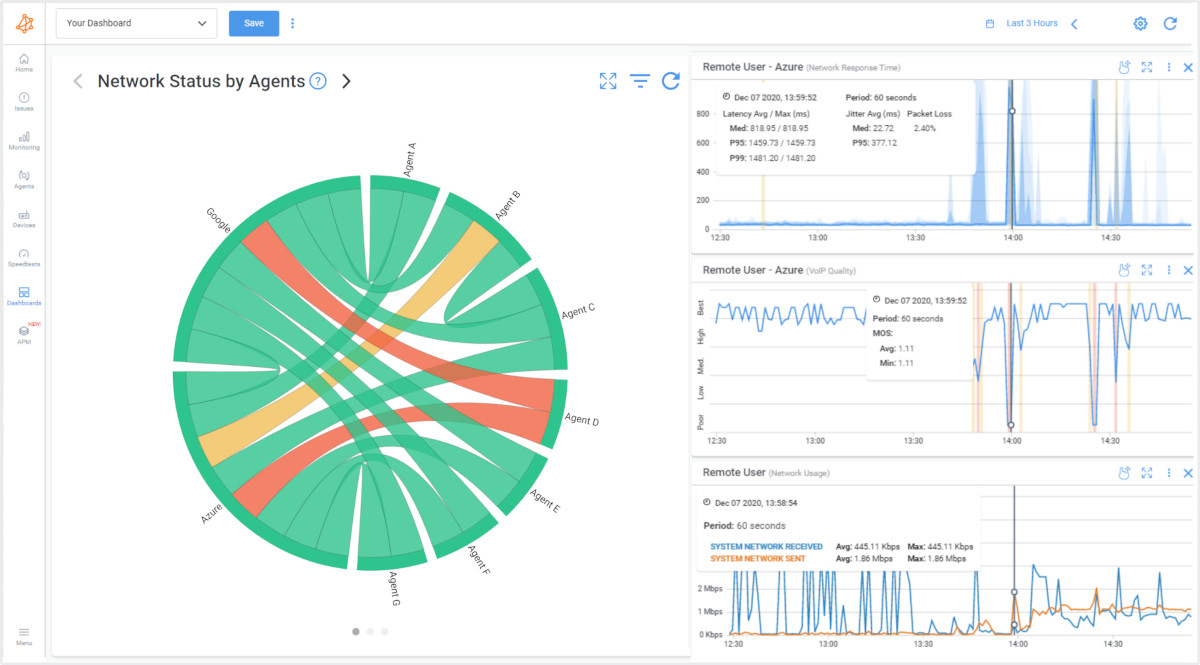
Here are just a few reasons why Obkio is the perfect tool for network connection monitoring:
- User-Friendly Interface: Obkio has an intuitive interface that is easy to navigate, even for non-technical users. Set up and configure the tool with just a few clicks, and monitor your network performance in real-time with customizable dashboards.
- Detailed Network Metrics: Obkio provides detailed metrics and analytics that help you to understand the performance of your network. You can view data on network latency, packet loss, bandwidth usage, and other key performance indicators, making it easier to identify connectivity issues and optimize your network for maximum efficiency.
- Proactive Alerts and Notifications: Obkio offers customizable alerts and notifications that alert you to potential network connectivity issues before they become major problems. You can set up network monitoring alerts based on specific performance metrics, such as high latency or packet loss.
- Scalability: Obkio is a scalable solution that can be used to monitor networks of all sizes, from small offices to large enterprise networks. You can easily add new agents and

To stay ahead of the pack with network connection monitoring, it's important to keep an eagle eye on every aspect of your network. Whether it's the WAN, LAN, or network devices, you need to be on the lookout for any potential network connection issues.
That's where Obkio's Network Monitoring Agents come in! These trusty agents are strategically placed at key network locations and constantly exchange synthetic traffic (every 500ms) to monitor performance and sniff out any network issues. So you can sit back, relax, and let the agents do the heavy lifting for you!
- Choose an Agent: Obkio provides different agent types (Windows, macOS, Linux, etc) that you can use to monitor different aspects of your network, including network devices, servers, and applications. You should choose an agent based on your specific monitoring needs but we recommend that you deploy:
- Local Agents: Installed in the targeted office location experiencing network connectivity issues. There are several Agent types available (all with the same features), and they can be installed on MacOS, Windows, Linux and more.
- Public Monitoring Agent: These are deployed over the Internet and managed by Obkio. They compare performance up to the Internet and quickly identify if the network connectivity issue is global or specific to the destination. This will be great information for later in the troubleshooting process. You can use an AWS or Google Cloud Agent.
- Install the Agents: Once you’ve chosen the agents, you will need to install them on the device you want to monitor. The installation process varies depending on the agent you choose, but in general, it involves downloading the agent installer and running it on the device.
- Configure the Agent: After you have installed the agent, you will need to configure it to start monitoring your network. This involves entering the necessary credentials and settings, such as the IP address of the device you want to monitor and the metrics you want to track.
- Verify Connectivity: Once the agent is installed and configured, you should verify that it is successfully monitoring your network connections. You can do this by checking the dashboard on Obkio's web interface, which will show you real-time metrics and alerts for the device you are monitoring.
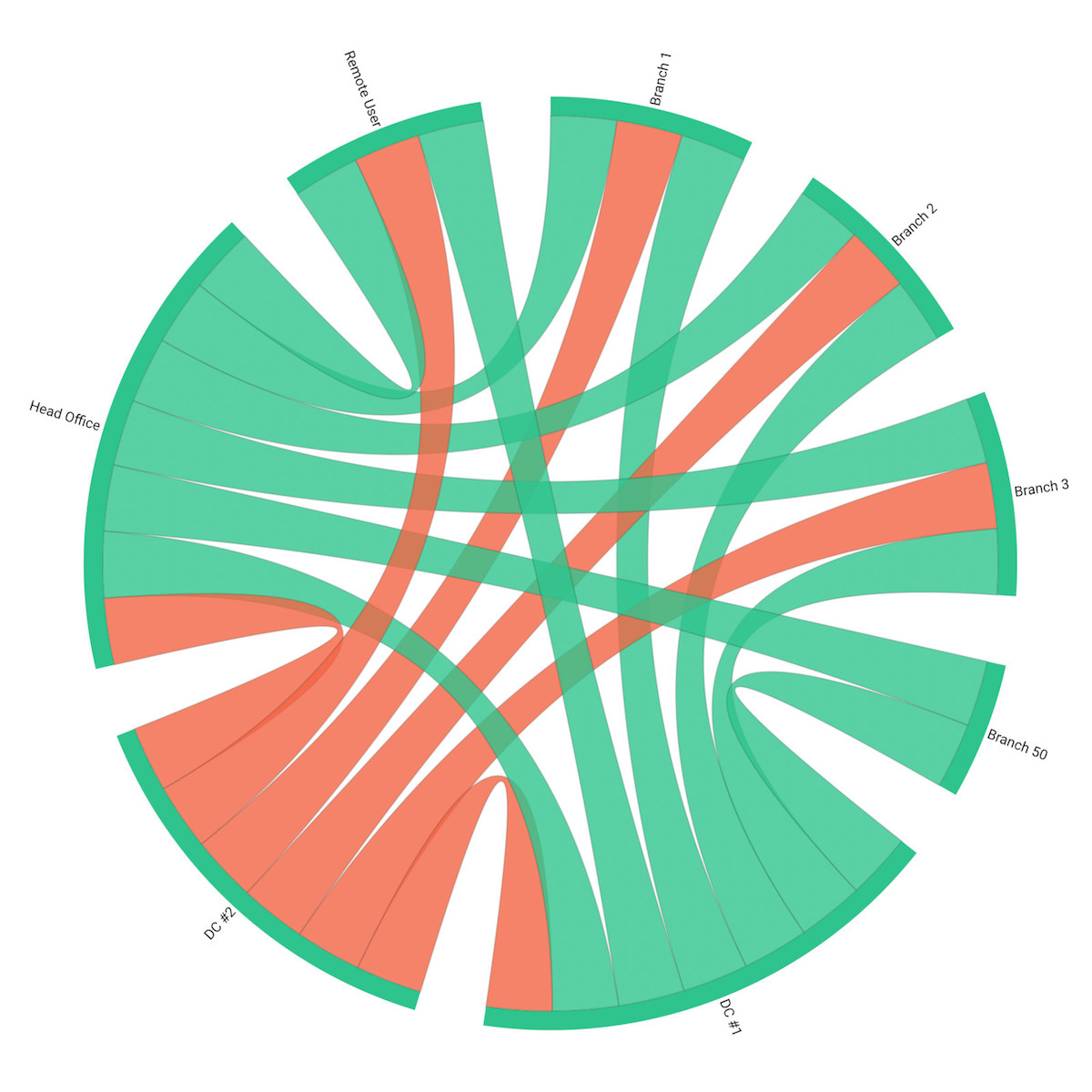
Unleash the power of your Network Monitoring Agents and unlock a treasure trove of insights into your network's performance! Once deployed, these tireless agents engage in synthetic traffic exchange, meticulously measuring vital network metrics across all your locations.
With the advanced analytics of Obkio’s Network Monitoring tool, you gain the upper hand in detecting and addressing potential issues that might impact your network's connection. Experience the benefits of smoother operations and heightened efficiency, ensuring uninterrupted productivity for your business.
Here are some of the network metrics you’ll be measuring:
- Latency: Latency refers to the time it takes for a packet of data to travel from one point in the network to another. High latency can cause delays in the transmission of data across the network. This delay can lead to slower network performance and can even result in dropped packets, which can cause data loss and impact overall network connection.
- Packet Loss: Packet Loss refers to the percentage of packets of data that are lost in transit between two points. High packet loss can result in dropped packets and can negatively impact network connection. When packets are lost, data needs to be retransmitted, which can slow down network performance and cause delays.
- Jitter: Jitter refers to the variation in delay between packets of data in a network. High jitter can cause delays in the transmission of data across the network. When there is significant variation in the delay between packets, it can lead to slower network performance and impact overall network connection.
- Bandwidth Usage: Bandwidth Usage measures the amount of data transmitted over a network over a given period. High bandwidth usage can lead to network congestion, which can cause delays and impact overall network connection. When the network is congested, it can be challenging for data to be transmitted efficiently, resulting in slower network performance.
- Availability: Network Availability measures the percentage of time that a network or device is available and operational. Low availability can cause network disconnection, as devices that are unavailable can't transmit data. When devices are offline, it can also impact the network's ability to route data, resulting in slower network performance.
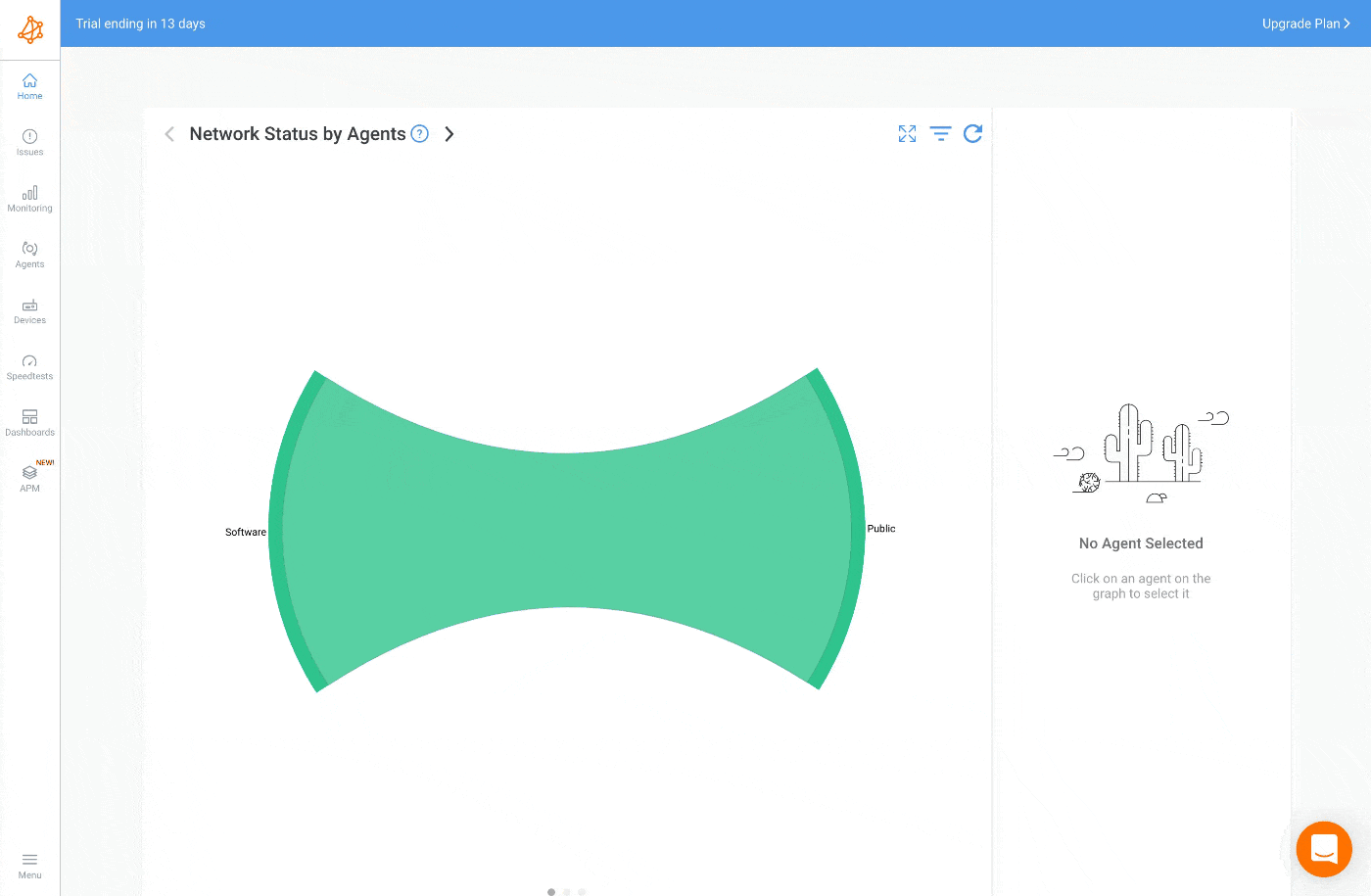
Keeping tabs on your network's performance is crucial for maintaining the best network connection quality. When you’re measuring network metrics, here are three pro tips to keep in mind:
- Analyze Graphs: Obkio’s Network Response Time Graph provides a real-time view of your network's performance metrics. You can quickly see the status of all your devices and applications, and identify any issues that may be affecting network connection.
- Identify Trends: By monitoring network metrics over time, you can identify trends and patterns that may indicate issues with your network connection. For example, if you notice a sudden increase in latency or packet loss, it may be a sign that a network device is experiencing issues.
- Set Automatic Alerts: Obkio provides alerts that can notify you of any issues with your network connection, so you can take action immediately. You can set up custom alerts based on specific performance metrics, such as latency or packet loss thresholds, and receive notifications via email.
The health and status of network devices are vital for maintaining a robust and dependable network connection. Monitoring these devices is as essential as tracking performance metrics such as latency, packet loss, and bandwidth usage. By doing so, you guarantee that all network devices are connected and functioning optimally, mitigating the risk of any connection mishaps and ensuring a smooth and uninterrupted network experience.
Luckily, Obkio also has its Network Device Monitoring feature to help you!
- Choose Devices to Monitor: You should select the devices that are critical to your network's operation and monitor their status and performance. This includes routers, switches, servers, and other network devices.
- Add Your Devices: Once you’ve installed your monitoring agents from step 2, you can then start monitoring your network devices using SNMP by adding the devices inside the Obkio App. The devices just need to support SNMP polling.
- Ultra-Fast SNMP Polling: Once you’ve added your network devices, Obkio’s Network Device Monitoring feature uses Ultra-Fast Polling (every 30 seconds) to provide results that are far more precise than the traditional software polling, which occurs every 5 minutes.
By monitoring network devices, you can quickly identify and troubleshoot connection issues caused by device failures, misconfigurations, or other issues. This helps ensure that your network is operating efficiently and that your devices are properly connected, leading to a more reliable and efficient network experience.
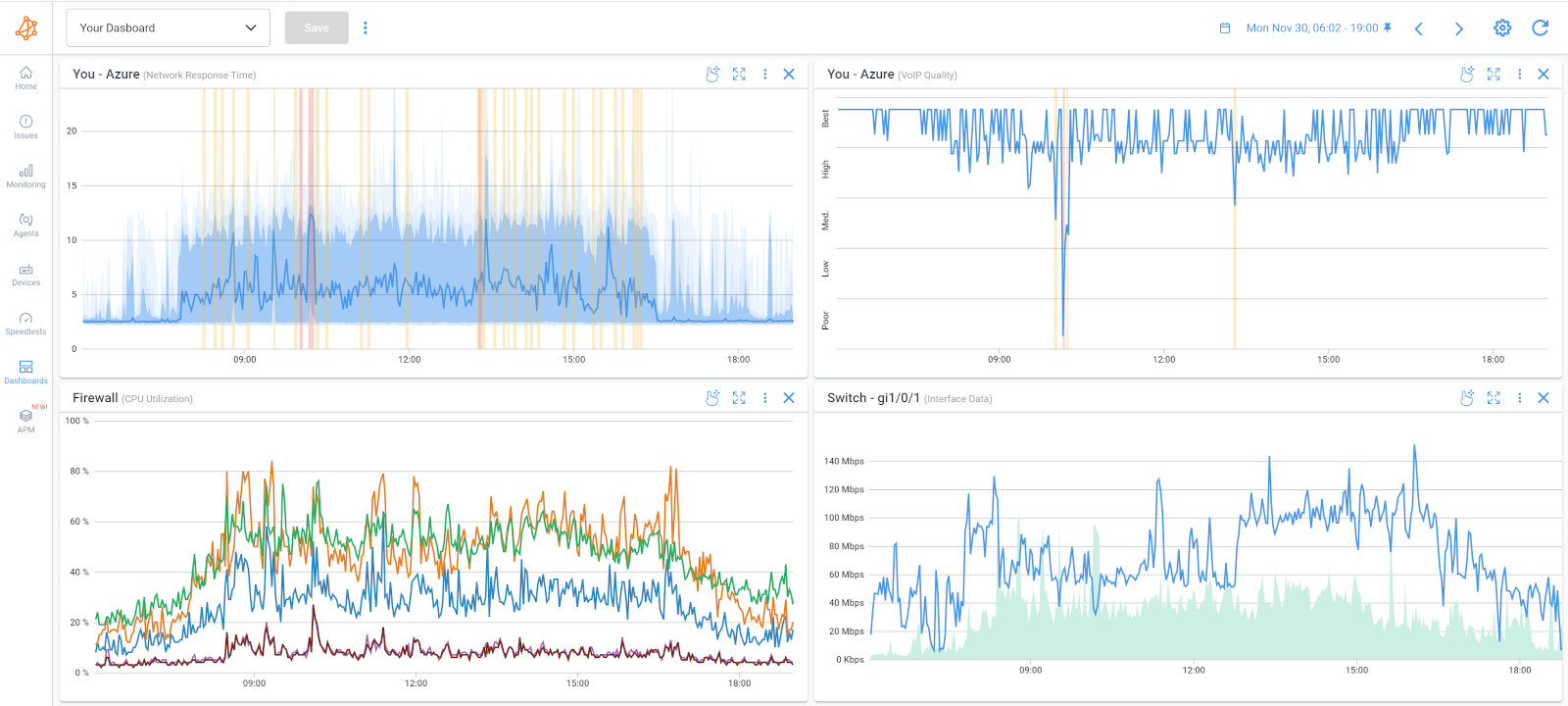
When it comes to network connection monitoring, it's not just about tracking network performance metrics. You also need to keep an eye on your network devices to ensure they're in tip-top shape! After all, a network is only as strong as its weakest device.
Here are some key network device metrics to measure:
- CPU Usage: This measures the percentage of a device's processing power that is being used. High CPU usage can cause network devices to slow down or become unresponsive. When a device's CPU is overwhelmed, it may struggle to process incoming data and respond to requests, resulting in slower network performance and potential connection issues.
- Memory Usage: This measures the amount of memory that a device is using. High memory usage can cause network devices to slow down or become unresponsive. When a device's memory is filled, it may struggle to store and process incoming data, resulting in slower network performance and potential connection issues.
- Interface Traffic: This measures the amount of data transmitted and received by a network interface. High interface traffic can cause network devices to become congested, leading to slower network performance and potential connection issues. When there is significant traffic on an interface, it can be challenging for the device to process incoming data and respond to requests, which can result in delays and connection issues.
- Interface Errors: This measures the number of errors that occur on a network interface, such as packet drops or collisions. High interface errors can impact network connection by causing data loss and delays. When there are errors on a network interface, such as packet drops or collisions, it can cause data to be lost or delayed, which can negatively impact overall network performance and connection.
- Device Availability: This measures the percentage of time that a device is available and operational. Low device availability can result in network connection issues, as devices that are offline or unavailable can't transmit data. When devices are unavailable, it can also impact the network's ability to route data, resulting in slower network performance and potential connectivity issues.
By measuring these network device metrics with Obkio Network Monitoring tool, you can identify issues that may be impacting network connection and take action to resolve them quickly. You can also set up custom alerts based on thresholds for each of these metrics, so you can be notified as soon as an issue arises.
Say goodbye to waiting around for network issues to strike with Obkio Network Monitoring tool. Take a proactive approach and stay one step ahead of potential problems. By configuring alerts and notifications, you receive instant notifications when an issue arises, enabling you to take immediate action and restore network functionality smoothly.
Obkio offers a range of alert options, including email, webhook alerts, and integration with PagerDuty, allowing you to select the method that best suits your preferences. Set personalized alert thresholds based on specific network or device metrics, ensuring you receive notifications tailored to your network's unique requirements. With customizable alert templates, you have full control over the content and format of your alerts.
By harnessing Obkio's robust alert system, you can rest assured that no network issue will go unnoticed. Stay on top of your network's performance and provide your users with a seamless experience they can rely on. Leave behind the uncertainty and embrace the power of proactive network monitoring with Obkio.


In this section, we explore various methods that empower businesses to gather insights and monitor their network connections. In the previous section, we showed you how to deploy Network Connection Monitoring with an end-to-end monitoring tool that encompasses many of the techniques we’re about to describe.
Here are some common techniques employed to gather information and insights about network connections:
This technique involves capturing and analyzing network packets to gain detailed information about network traffic, protocols used, and data payloads. Packet capture tools, such as Wireshark, allow administrators to examine individual packets and understand network behaviour at a granular level.
Flow monitoring focuses on analyzing aggregated traffic flows rather than individual packets. It provides high-level information about network conversations, including source and destination IP addresses, ports, and traffic volume. Flow monitoring tools, like NetFlow and sFlow, help administrators identify traffic patterns, detect anomalies, and monitor bandwidth usage.
Simple Network Management Protocol (SNMP) is a protocol used to manage and monitor network devices. SNMP monitoring involves querying SNMP-enabled devices to gather data about their status, performance metrics, and other relevant information. SNMP monitoring tools provide centralized management and monitoring of network devices, allowing administrators to track device health and performance.
Obkio’s network monitoring tool uses SNMP monitoring to monitor the health of network devices.
Learn about what SNMP monitoring is & how to use it to monitor performance of networking devices like firewalls, routers, switches and wifi access points.
Learn more

Performance monitoring techniques focus on measuring key performance metrics such as latency, packet loss, and bandwidth utilization. This involves continuously collecting data from network devices, routers, switches, and servers using tools like ping, traceroute, and SNMP. Performance monitoring tools provide real-time or near-real-time insights into network performance, allowing administrators to identify and resolve performance-related issues.
Synthetic Monitoring involves simulating network traffic by generating artificial data packets. This technique helps assess network performance, measure response times, and identify potential bottlenecks. Synthetic monitoring tools, like Obkio, send controlled packets across the network, allowing administrators to evaluate performance under different scenarios and stress test the network.
Learn how to use synthetic monitoring to monitor network performance & identify network issues, and the benefits of synthetic traffic over packet capture.
Learn more

Endpoint monitoring focuses on monitoring network connections from individual devices, such as workstations, laptops, or servers. Endpoint monitoring tools track device connectivity, network usage, and security-related events on individual endpoints, providing insights into device-level network behaviour and potential security threats.
By utilizing these network connection monitoring techniques, businesses can gain a comprehensive understanding of their network infrastructure, detect anomalies, optimize performance, and ensure the smooth and secure operation of their networks.


In this section, we delve into the vital metrics that businesses need to monitor to ensure optimal network performance and reliability. By understanding and analyzing these metrics, businesses can proactively address issues, optimize resource allocation, and deliver a seamless network experience.
Several network metrics play a crucial role in network connection monitoring. Here are some of the most important metrics that provide valuable insights into network performance and health:
- Latency: Latency measures the time it takes for a data packet to travel from its source to its destination and back. It indicates the delay experienced in network communication and is critical for applications that require real-time responsiveness. Measuring latency helps identify bottlenecks, network congestion, or performance issues that may affect user experiences.
- Packet Loss: Packet loss refers to the percentage of data packets that do not reach their destination within a given time frame. It can occur due to network congestion, faulty equipment, or other issues. Measuring packet loss helps identify network reliability issues and potential causes that may impact data integrity and application performance.
- Bandwidth Utilization: Bandwidth utilization measures the amount of network capacity being used at a given time. Measuring bandwidth utilization helps identify periods of high traffic and potential congestion points. It allows businesses to optimize bandwidth allocation, ensure sufficient capacity for critical applications, and identify potential network bottlenecks.
- Network Throughput: Network throughput measures the amount of data transferred over a network in a given time period. It reflects the network's data transmission capacity and indicates the efficiency of data transfer. Measuring network throughput helps identify performance limitations and ensures that data is flowing smoothly across the network.
- Error Rates: Error rates indicate the occurrence of transmission errors or data corruption during network communication. Monitoring error rates helps identify network issues, faulty devices, or communication problems that may affect data integrity and network reliability.
- Network Availability: Availability measures the percentage of time that the network or specific network devices are operational and accessible. Monitoring availability helps identify periods of downtime, network outages, or device failures, enabling businesses to address issues promptly and minimize disruptions.
These network metrics provide critical insights into network performance, reliability, and potential issues. By monitoring and analyzing these metrics, businesses can proactively address network problems, optimize performance, and ensure a seamless and reliable network connection.
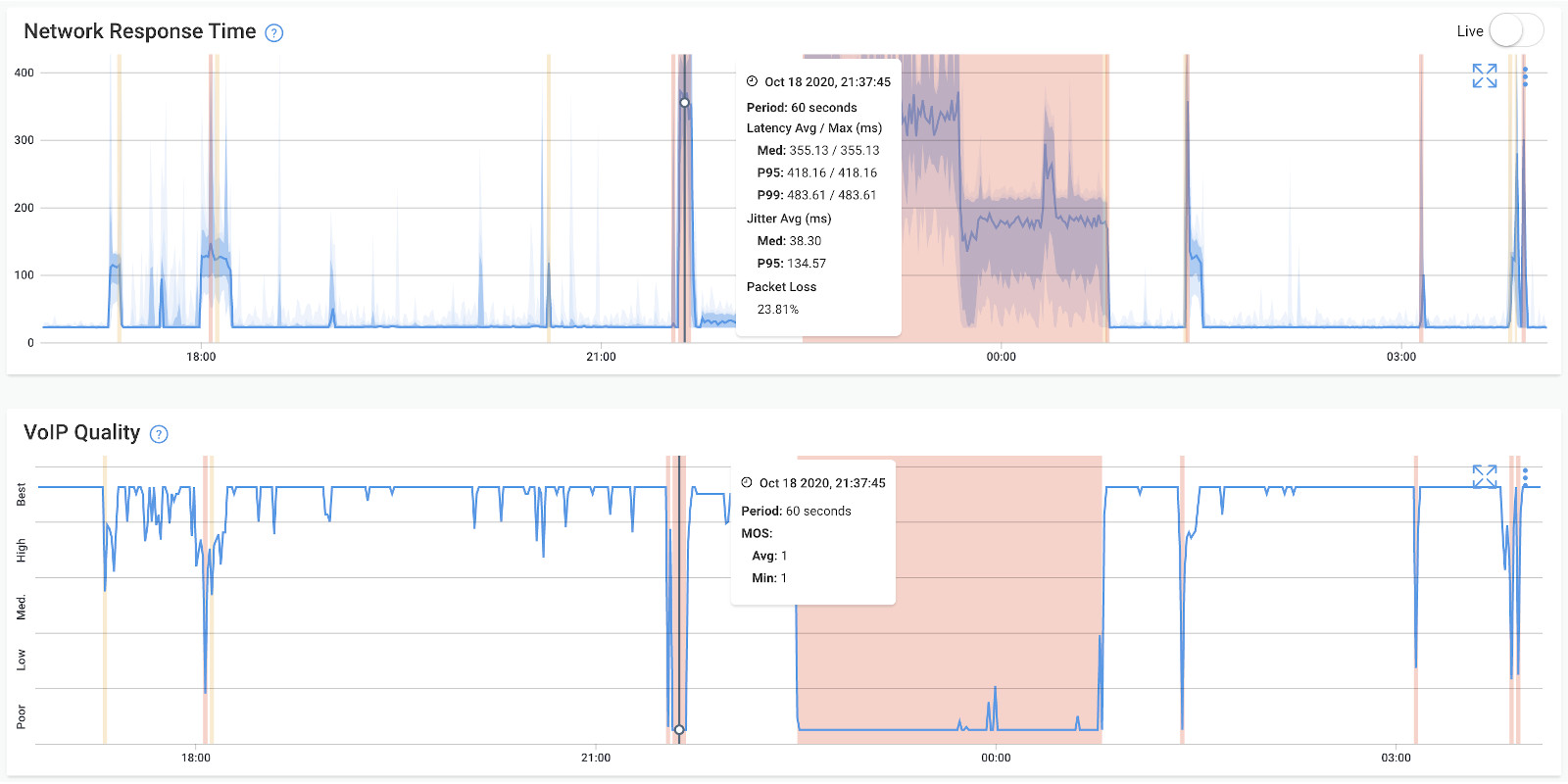

With your network connection monitoring setup, you’ll be able to automatically and proactively detect any network connection issues that may be affecting your network. Identifying the root cause of these problems can challenging, but that’s why you have a network connection monitoring tool, like Obkio!
Because many network connection issues are difficult to spot, it's important to familiarize yourself with the most common issues so you know what to expect. Let's dive into some of them now.
- Network Congestion: Network congestion occurs when there is excessive data traffic on the network, leading to slower performance and delays in data transmission. It can be caused by bandwidth limitations, inadequate network infrastructure, or an overload of connected devices.
- Latency: Latency refers to delays in data transmission between network endpoints. High latency can result in sluggish response times, impacting real-time applications such as video conferencing or online gaming. Latency issues may be caused by long distances between endpoints, network congestion, or inefficient routing.
- Packet Loss: Packet loss happens when data packets fail to reach their intended destination. It can occur due to network congestion, hardware issues, or transmission errors. Packet loss can lead to data corruption, reduced application performance, and disrupted network connections.
- Network Outages: Network outages are complete disruptions of network connectivity, rendering devices unable to communicate with each other or access the internet. Outages can be caused by power failures, equipment malfunctions, network misconfigurations, or external factors such as natural disasters.
- DNS Issues: Domain Name System (DNS) problems can prevent devices from translating domain names into IP addresses, resulting in difficulty accessing websites or services. DNS issues can occur due to misconfigurations, DNS server failures, or problems with internet service providers.
- Security Breaches: Network security breaches can compromise the confidentiality, integrity, or availability of network resources. They may involve unauthorized access to network devices, data breaches, malware infections, or denial-of-service (DoS) attacks. Security vulnerabilities in network devices or weak security practices can lead to such breaches.
- Hardware or Device Failures: Hardware or device failures can disrupt network connections and lead to downtime. Faulty network switches, routers, or network interface cards (NICs) can cause intermittent or complete loss of connectivity.
By being aware of these common network connection problems, businesses can proactively implement measures to prevent or quickly resolve issues. This may involve optimizing network infrastructure, employing network monitoring tools, implementing security measures, and promptly addressing hardware or configuration-related problems.
Now that you are aware of the network connection issues, it's time to find out what's causing them.
Obkio's Monitoring Agents are installed at every end of your network p to pinpoint the exact location of network connection issues. By setting up alerts for network metrics like latency, packet loss, and bandwidth usage, you can identify the root cause of connection issues. Additionally, Obkio helps you identify issues with specific network devices, such as routers and switches, enabling you to address the problem.
There are several potential causes of network connection issues. Let's take a look at some of the most common ones.
- Network Misconfigurations: Incorrect configurations of network devices, such as routers, switches, or firewalls, can lead to connectivity issues. Misconfigured IP addresses, subnet masks, gateway settings, or DNS settings can disrupt communication between devices.
- Hardware Failures: Faulty network equipment, such as routers, switches, or network interface cards (NICs), can result in intermittent or complete loss of connectivity. Hardware failures may include malfunctioning components, damaged cables, or power supply issues.
- Network Congestion: Network congestion occurs when there is excessive traffic on the network, leading to performance degradation and slower data transmission. It can be caused by insufficient bandwidth, heavy data usage, or inefficient network routing.
- Software or Firmware Issues: Software bugs, outdated firmware, or incompatible network drivers can cause network connection problems. These issues may affect the performance of network devices and result in intermittent connectivity or disruptions.
- Security Measures and Firewalls: Strict security measures or misconfigured firewalls can block or restrict network connections. Overly aggressive firewall rules, access control lists (ACLs), or intrusion prevention systems (IPS) can inadvertently block legitimate network traffic.
- DNS Problems: Domain Name System (DNS) issues can prevent devices from translating domain names into IP addresses, leading to difficulty accessing websites or services. DNS misconfigurations, DNS server failures, or problems with DNS resolution can cause connection problems.
- Physical Obstacles: Physical obstacles, such as walls, distance, or interference from other electronic devices, can weaken or disrupt wireless network signals. This can result in poor connectivity or limited range for Wi-Fi networks.
- Internet Service Provider (ISP) Issues: Problems with the Internet service provider, such as network outages, maintenance activities, or infrastructure problems, can impact network connectivity. Issues with the ISP's network backbone or connectivity to the internet can cause disruptions.
By understanding the common causes of network connection issues, businesses can take proactive steps to address and prevent them. Regular network maintenance, proper configuration management, hardware inspections, and keeping software/firmware up to date are essential practices to maintain reliable network connectivity.
Learn how to detect intermittent network problems to troubleshoot performance issues that are hard to catch with Obkio Network Monitoring software.
Learn more

To add to the complexity of monitoring network connection, many network connection issues are actually intermittent. Intermittent network connection refers to a situation where a network experiences sporadic or inconsistent connection issues. In other words, it is a type of network connectivity issue that occurs periodically and unpredictably.
Like with other intermittent network problems, and intermittent Internet connection, intermittent network connectivity issues are much more difficult to catch and troubleshoot.
With Obkio Network Monitoring tool, you don't have to worry about intermittent network connection issues going unnoticed. Leverage historical data to identify intermittent issues by analyzing network performance metrics over time. Obkio allows you to store and analyze historical data, providing you with a wealth of information to analyze and identify patterns of intermittent connectivity issues.
- Look for patterns: By reviewing historical data, you can look for patterns of performance degradation and identify specific times and dates when connection issues have occurred.
- Compare past data: You can also compare performance metrics during periods of normal network performance to those during periods of degraded performance. For example, if you notice that network latency increases during specific times of the day or on certain days of the week, you can use this information to identify potential causes of the intermittent connection issues, such as increased network traffic during peak usage times or scheduled backups that are affecting network performance.
- Proactively identify issues: Analyzing historical data can also help you identify trends and potential issues before they become major problems. By proactively addressing these issues, you can prevent future network downtime and ensure that your network is running optimally.
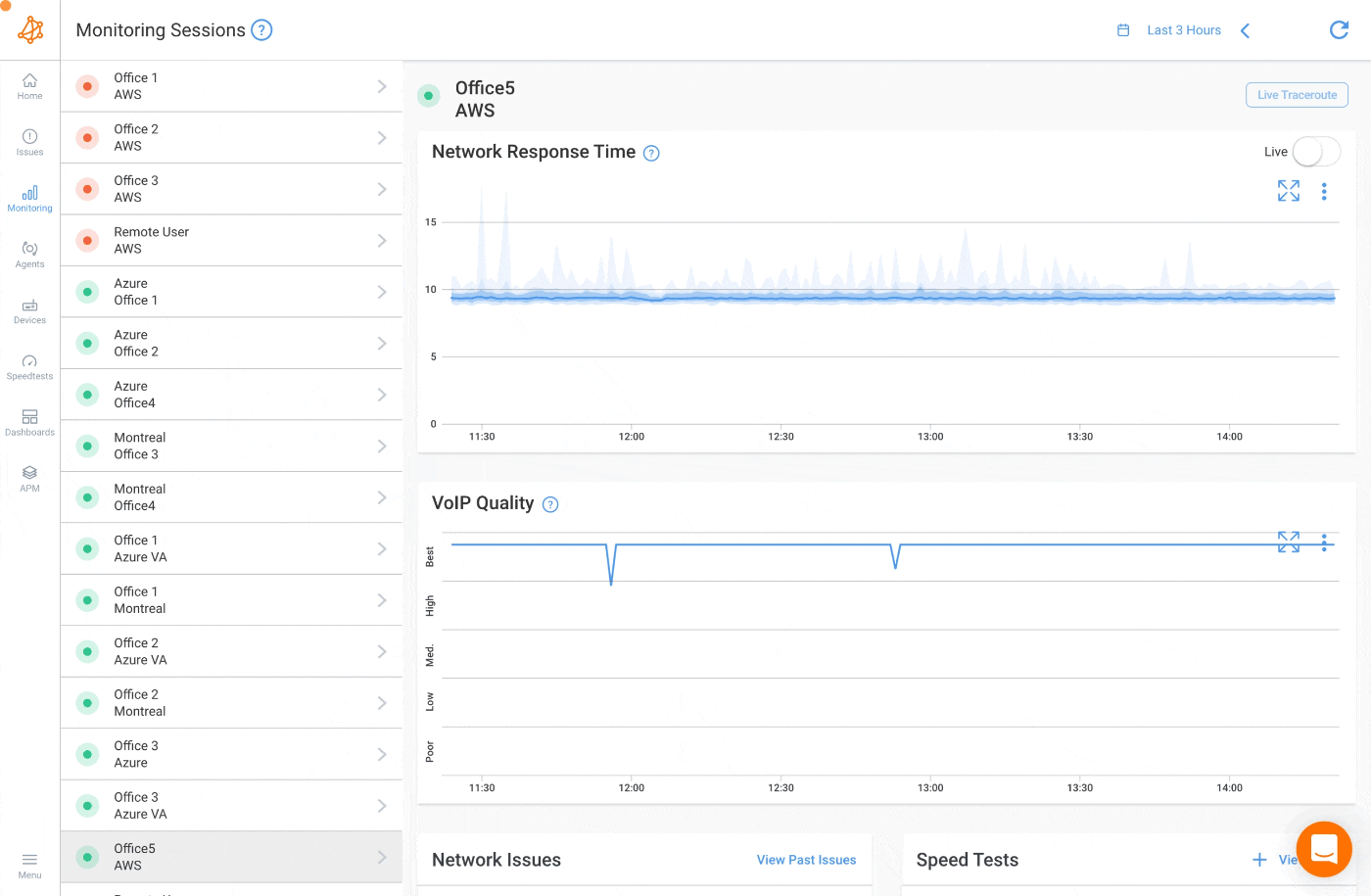
We’re almost at the end of this journey - but before we let you go to start monitoring your network connection, there’s something we want to emphasize.
Continuous network connectivity monitoring plays a crucial role in maintaining the optimal performance, reliability, and security of a network. That’s why you should always keep your network connection monitoring tool, or network performance monitoring tool, as a permanent member of your IT team!
Here are the key reasons highlighting the importance of continuous network connectivity monitoring:
- Early Issue Detection and Resolution: Network connectivity monitoring enables the early detection of potential issues or anomalies in the network. By continuously monitoring network connections, businesses can promptly identify and address problems such as latency issues, packet loss, or network congestion. Timely detection allows for swift troubleshooting and resolution, minimizing the impact on network performance and user experience.
- Downtime Prevention and Minimization: Downtime can be costly for businesses, resulting in lost productivity, revenue, and customer dissatisfaction. Continuous network connectivity monitoring helps proactively identify vulnerabilities, hardware failures, or configuration errors that could lead to network outages. By detecting and resolving these issues in advance, organizations can prevent or minimize downtime, ensuring uninterrupted operations and customer satisfaction.
- Optimal Performance and Resource Allocation: Network connectivity monitoring provides insights into network performance metrics such as latency, bandwidth utilization, and packet loss. By monitoring these metrics, businesses can optimize resource allocation, identify network bottlenecks, and make informed decisions to enhance network performance. This ensures efficient utilization of network resources, improved application response times, and a seamless user experience.
- Security Breach Detection: Continuous network connectivity monitoring plays a critical role in identifying potential security breaches or unauthorized access attempts. Monitoring network traffic patterns and behaviour helps detect anomalies, such as unusual data transfers, suspicious IP addresses, or signs of malware activity. By monitoring network connectivity, businesses can identify security threats early on, take appropriate actions to mitigate risks and safeguard their sensitive data and infrastructure.
- Capacity Planning and Scalability: Network connectivity monitoring provides insights into network utilization and traffic patterns, allowing businesses to plan for future capacity requirements. By monitoring network connections continuously, organizations can identify trends, anticipate growth, and make informed decisions regarding network upgrades or scaling efforts. This ensures that the network infrastructure can support evolving business needs and accommodate increased demand without performance degradation.
- Compliance and Reporting: Continuous network connectivity monitoring helps organizations meet regulatory compliance requirements and internal auditing standards. By monitoring and documenting network connectivity, businesses can demonstrate adherence to security policies, data protection regulations, and service-level agreements. It provides a historical record of network performance and enables accurate reporting on network availability, performance metrics, and security incidents.
In summary, continuous network connectivity monitoring is vital for ensuring optimal network performance, proactive issue detection and resolution, security protection, and efficient resource allocation. By monitoring network connections in real time, businesses can maintain a robust and reliable network infrastructure, enhance user experiences, and support their overall business objectives.


this section, we're diving into some fantastic tips to boost your network's performance and reliability using the power of network connection monitoring. With these tips up your sleeve, you'll be able to transform your network into a well-oiled machine, delivering lightning-fast speeds and rock-solid connectivity.
Improving network connection can be achieved through effective network connection monitoring. Here are some tips to enhance network connectivity using monitoring techniques:
- Identify and Address Bottlenecks: Network connection monitoring helps identify bottlenecks that hinder network performance. By analyzing metrics such as latency, packet loss, and bandwidth utilization, businesses can pinpoint areas causing congestion or slowdowns. Taking proactive steps to resolve these bottlenecks, such as optimizing network configurations, upgrading hardware, or adjusting traffic prioritization, can significantly improve network connection.
- Optimize Network Configuration: Continuous network connection monitoring enables businesses to assess the effectiveness of their network configurations. By monitoring metrics like routing paths, firewall rules, and Quality of Service (QoS) settings, organizations can identify misconfigurations or suboptimal settings. Making appropriate adjustments based on monitoring insights can optimize network performance and ensure smooth connectivity.
- Implement Traffic Prioritization: Network connection monitoring helps identify critical applications or services that require priority access to network resources. By leveraging monitoring tools, businesses can implement traffic prioritization mechanisms like Quality of Service (QoS) or bandwidth allocation to ensure that essential applications receive sufficient network resources, enhancing their performance and maintaining reliable connectivity.
- Proactive Troubleshooting: Network connection monitoring allows businesses to detect and address issues proactively, minimizing downtime and disruptions. By configuring alerts and notifications based on specific network metrics, businesses can be immediately alerted to anomalies or threshold breaches. Timely notifications enable IT teams to investigate and troubleshoot issues promptly, ensuring quick network troubleshooting and continuous network connectivity.
- Capacity Planning and Scalability: Monitoring network connection metrics over time provides valuable insights for capacity planning and scalability. By analyzing historical data on network utilization, businesses can forecast future capacity requirements, anticipate traffic growth, and plan for network expansion or upgrades accordingly. This proactive approach ensures that network resources can handle increasing demands and maintain optimal connection performance.
- Security Monitoring: Network connection monitoring plays a crucial role in detecting and mitigating security threats. By monitoring network traffic patterns, anomalies, and unauthorized access attempts, organizations can identify potential security breaches. Continuous monitoring enables prompt response to security incidents, implementation of appropriate security measures, and safeguarding the network infrastructure.
By incorporating these tips and leveraging network connection monitoring tools effectively, businesses can optimize network performance, enhance connectivity, and provide a seamless and reliable network experience for their users.
Unlock the secrets of network monitoring basics in this article. Dive into everything you need to get started with ease – it's not rocket science!
Learn more

As we bid adieu, remember that network connection monitoring is the secret sauce to achieving network nirvana for your business. By harnessing the power of monitoring techniques and metrics, you can uncover hidden network gems, troubleshoot with lightning speed, and keep your network running like a well-choreographed dance routine.
But why stop there? Take your network monitoring journey to the next level with Obkio. With its user-friendly interface, customizable alerts, and real-time insights, Obkio is your trusty sidekick in the world of network connectivity. Say goodbye to network woes and hello to a world where connection hiccups are a thing of the past.

Embrace the power of Obkio and embark on a never-ending quest to ensure seamless, efficient, and robust network connectivity for your business. Your network deserves the best, and with Obkio by your side, you'll conquer the network universe with a smile.
Start Monitoring network connection for free!
- 14-day free trial of all premium features
- Deploy in just 10 minutes
- Monitor performance in all key network locations
- Measure real-time network metrics
- Identify and troubleshoot live network problems



























 Obkio Blog
Obkio Blog








